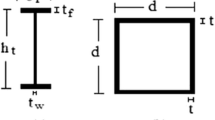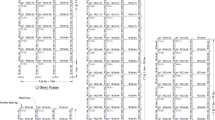Abstract
In an incremental dynamic analysis (IDA) using a set of ground motion records, nonlinear time history analysis needs to be performed on structures. It is well recognized that IDA calls for high computational efforts and the results are highly sensitive to selected ground motions. As a result, alternative static methods are needed. This study aims to introduce a new double-stage (N1- N2) static method to estimate capacity curves of MR frames. The technique is regulated to resemble IDA results with specific emphasis on near-field ground motions. Using an ensemble of 56 near-field earthquake records, required IDAs have been carried out for SAC-Los Angeles 3-, 9- and 20-story buildings and an additional 15-story building. The results of the proposed static method are compared with those from IDA, displacement-based adaptive procedure (DAP), and multimodal procedure (MMP). The results indicate that in addition to enhanced accuracy, very little time is required in the case of N1-N2 method. Thus, for the 3-story structure, the time required is less than 1 minute. The proposed N1-N2 method shows the best accuracy in terms of lateral mechanisms for the 15-story frame while for the other cases, the first mode load pattern leads to the best accuracy.
Similar content being viewed by others
References
American Institute of Steel Construction (AISC, 2010), “Specification for Structural Steel buildings (ANSI/ AISC 360–10),” Chicago, Illinois 60601–1802.
American Society of Civil Engineers (ASCE, 2010), “Minimum Design Loads for Buildings and Other Structures (ASCE/SEI 7–10),” Reston, Virginia.
Baker JW and Cornell CA (2006), “Spectral shape, epsilon and record selection,” Earthquake Engineering and Structural Dynamics, 35: 1077–1095.
Bracci JM, Kunnath SK and Reinhorn AM (1997), “Seismic Performance and Retrofit Evaluation of Reinforced Concrete Structures,” Journal of Structural Engineering, 3–10.
Elnashai AS (2001), “Advanced Inelastic Static (pushover) Analysis for Earthquake Applicatios,” Structural Engineering and Mechanics, 12(1): 51–69.
Federal Emergency Management Agency (FEMA, 2009), “Quantification of Building Seismic Performance Factors (FEMA–P695),” Washington, D.C.
Gupta A and Krawinkler H (1999), “Seismic Demands for Performance Evaluation of Steel Moment Resisting Frame Structures,” the John A. Blume Earthquake engineering Center, Department of Civil and Environmental Engineering Stanford University, Report no. 132.
Han SW and Chopra AK (2006), “Approximate Incremental Dynamic Analysis Using the Modal Pushover Analysis Procedure,” Earthquake Engineering and Structural Dynamics, 35: 1853–1873.
Ibarra LF and Krawinkler H (2005), “Global Collapse of Frame Structures under Seismic Excitations,” the John A.Blume Earthquake engineering Center, Department of Civil and Environmental Engineering Stanford University, Report no. 132.
Ibarra LF, Medina RA and Krawinkler H (2005), “Hysteretic Models that Incorporate Strength and Stiffness Deterioration,” Earthquake Engineering and Structural Dynamics, 34: 1489–1511.
Krawinkler H (2000), “System Performance of Steel Moment Resisting Frame Structures,” 12th World Conference on Earthquake Engineering, Auckland, New Zealand.
Lignos D (2008), “Sidesway Collapse Deteriorating Structural Systems under Seismic Excitations,” a dissertation submitted to the department of civil of and environmental engineering and the committee on graduate studies of Stanford university in partial fulfillment of the requirements for the degree of doctor of philosophy.
Lignos D and Krawinkler H (2011), “Deterior ation Modeling of Steel Components in Support of Collapse Prediction of Steel Moment Frames under Earthquake Loading,” Journal of Structural Engineering, 1291–1302.
OpenSees, “Open System for Earthquake Engineering Simulation,” (http://opensees.berkeley.edu).
Papaniko L, Vassilis K, Elnashai AS and Pareja JF (2005), “Limits of Applicability of Conventional and Adaptive Pushover Analysis for Seismic Response Assessment,” Mid-America Earthquake Center, Civil and Environmental Engineering Department University of Illinois at Urbana-Champaign.
Pinho R and Antoniou S (2005), “A Displacementbased Adaptive Pushover Algorithm for Assessment of Vertically Irregular Frames,” 4th European Workshop on the Seismic Behavior of Irregular and Complex Structures, Thessaloniki, Greece.
Sasaki KK, Freeman SA and Paret TF (1998), “Multimodal pushover procedure (MMP),” Proceedings of sixth US national conference on Earthquake Engineering (Okland, Califorrnia), Earthquake Engineering Research Institute, 12 pages.
Tso WK and Moghadam AS (1998), “Pushover Procedure for Seismic Analysis of Buildings,” Structural Engineering and Materials, I(3): 337–344.
Author information
Authors and Affiliations
Corresponding author
Rights and permissions
About this article
Cite this article
Bahramirad, A., Tehranizadeh, M. & Moshref, A. Equating incremental dynamic analysis with static nonlinear analysis at near-field excitation. Earthq. Eng. Eng. Vib. 14, 465–476 (2015). https://doi.org/10.1007/s11803-015-0037-y
Received:
Accepted:
Published:
Issue Date:
DOI: https://doi.org/10.1007/s11803-015-0037-y




